初中语法一般现在时
- 格式:doc
- 大小:17.50 KB
- 文档页数:4
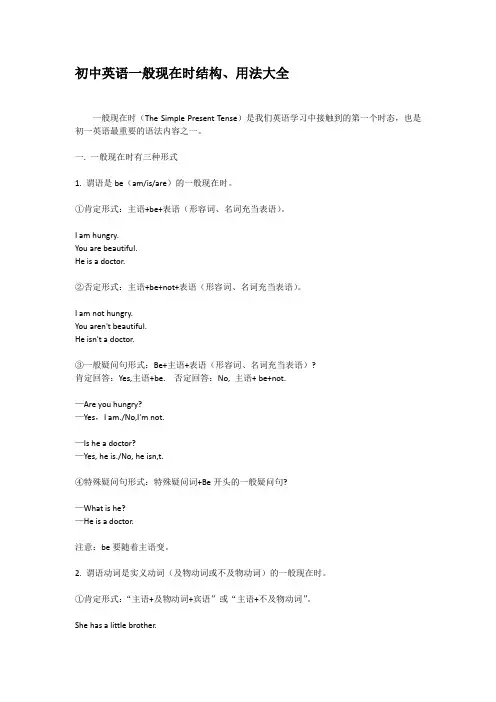
初中英语一般现在时结构、用法大全一般现在时(The Simple Present Tense)是我们英语学习中接触到的第一个时态,也是初一英语最重要的语法内容之一。
一. 一般现在时有三种形式1. 谓语是be(am/is/are)的一般现在时。
①肯定形式:主语+be+表语(形容词、名词充当表语)。
I am hungry.You are beautiful.He is a doctor.②否定形式:主语+be+not+表语(形容词、名词充当表语)。
I am not hungry.You aren't beautiful.He isn't a doctor.③一般疑问句形式:Be+主语+表语(形容词、名词充当表语)?肯定回答:Yes,主语+be. 否定回答:No, 主语+ be+not.—Are you hungry?—Yes,I am./No,I'm not.—Is he a doctor?—Yes, he is./No, he isn,t.④特殊疑问句形式:特殊疑问词+Be开头的一般疑问句?—What is he?—He is a doctor.注意:be要随着主语变。
2. 谓语动词是实义动词(及物动词或不及物动词)的一般现在时。
①肯定形式:“主语+及物动词+宾语”或“主语+不及物动词”。
She has a little brother.她有一个弟弟。
The sun rises in the east.太阳从东方升起。
②否定形式:“主语+don't/doesn't+及物动词+宾语”或“主语+don't/doesn't+不及物动词”。
She doesn't have a little brother.她没有弟弟。
I don't eat every morning.我每天早晨都不吃饭。
③一般疑问句形式:“Do/Does+主语+及物动词原形+宾语”或“Do/Does+主语+不及物动词原形”。
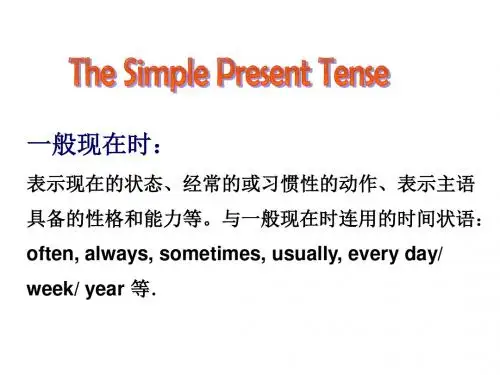
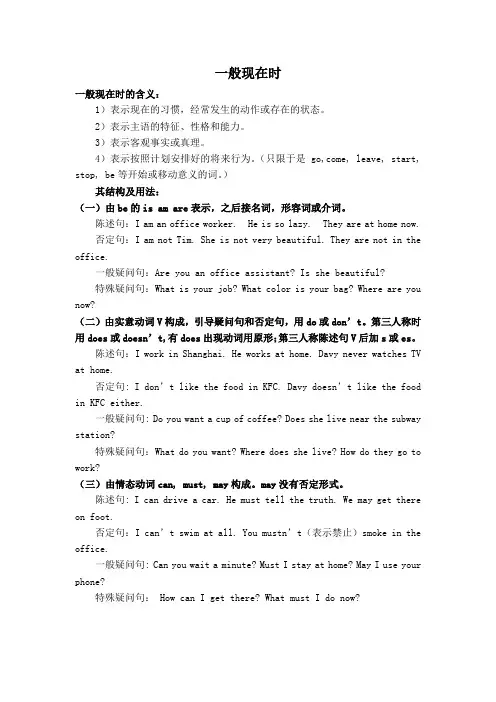
一般现在时一般现在时的含义:1)表示现在的习惯,经常发生的动作或存在的状态。
2)表示主语的特征、性格和能力。
3)表示客观事实或真理。
4)表示按照计划安排好的将来行为。
(只限于是go,come, leave, start, stop, be等开始或移动意义的词。
)其结构及用法:(一)由be的is am are表示,之后接名词,形容词或介词。
陈述句:I am an office worker. He is so lazy. They are at home now.否定句:I am not Tim. She is not very beautiful. They are not in the office.一般疑问句:Are you an office assistant? Is she beautiful?特殊疑问句:What is your job? What color is your bag? Where are you now?(二)由实意动词V构成,引导疑问句和否定句,用do或don’t。
第三人称时用does或doesn’t,有does出现动词用原形;第三人称陈述句V后加s或es。
陈述句:I work in Shanghai. He works at home. Davy never watches TV at home.否定句: I don’t like the food in KFC. Davy doesn’t like the food in KFC either.一般疑问句: Do you want a cup of coffee? Does she live near the subway station?特殊疑问句:What do you want? Where does she live? How do they go to work?(三)由情态动词can, must, may构成。

英语语法一般现在时,结构、用法全打尽!(附习题)一般现在时(The Simple Present Tense)是我们英语学习中接触到的第一个时态,也是初一英语最重要的语法内容之一。
和老师全方位学习一下吧!一. 一般现在时有三种形式1. 谓语是be(am/is/are)的一般现在时。
①肯定形式:主语+be+表语(形容词、名词充当表语)。
I am hungry.You are beautiful.He is a doctor.②否定形式:主语+be+not+表语(形容词、名词充当表语)。
I am not hungry.You aren't beautiful.He isn't a doctor.③一般疑问句形式:Be+主语+表语(形容词、名词充当表语)?肯定回答:Yes,主语+be. 否定回答:No, 主语+ be+not.—Are you hungry?—Yes,I am./No,I'm not.—Is he a doctor?—Yes, he is./No, he isn,t.④特殊疑问句形式:特殊疑问词+Be开头的一般疑问句?—What is he?—He is a doctor.注意:be要随着主语变。
2. 谓语动词是实义动词(及物动词或不及物动词)的一般现在时。
①肯定形式:“主语+及物动词+宾语”或“主语+不及物动词”。
She has a little brother.她有一个弟弟。
The sun rises in the east.太阳从东方升起。
②否定形式:“主语+don't/doesn't+及物动词+宾语”或“主语+don't/doesn't+不及物动词”。
She doesn't have a little brother.她没有弟弟。
I don't eat every morning.我每天早晨都不吃饭。
③一般疑问句形式:“Do/Does+主语+及物动词原形+宾语”或“Do/Does+主语+不及物动词原形”。
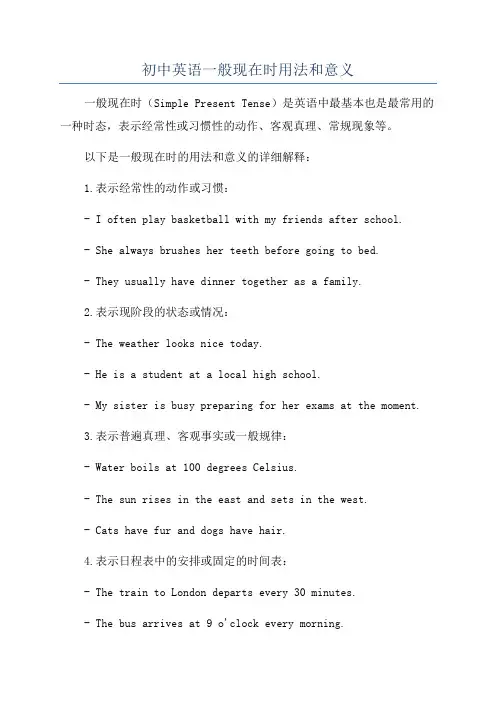
初中英语一般现在时用法和意义一般现在时(Simple Present Tense)是英语中最基本也是最常用的一种时态,表示经常性或习惯性的动作、客观真理、常规现象等。
以下是一般现在时的用法和意义的详细解释:1.表示经常性的动作或习惯:- I often play basketball with my friends after school.- She always brushes her teeth before going to bed.- They usually have dinner together as a family.2.表示现阶段的状态或情况:- The weather looks nice today.- He is a student at a local high school.- My sister is busy preparing for her exams at the moment.3.表示普遍真理、客观事实或一般规律:- Water boils at 100 degrees Celsius.- The sun rises in the east and sets in the west.- Cats have fur and dogs have hair.4.表示日程表中的安排或固定的时间表:- The train to London departs every 30 minutes.- The bus arrives at 9 o'clock every morning.- The English class takes place on Monday and Wednesday.5.表示评论、意见或个人观点:- I think he is a talented musician.- The movie is very interesting.- They believe in working hard to achieve success.6.表示感觉或外貌形态:- The cake smells delicious.- The flowers look beautiful in the garden.- The music sounds pleasant.7.口头表达指令、建议或禁令(一般情况下):- Close the door, please.- Don't run in the hallway.- Be quiet during the movie.8. 结构“there be”表示处存在物或人:- There is a park near my house.- There are many books on the shelf.- There is a girl waiting for you at the entrance.需要注意的是,一般现在时通常用于第三人称单数时,动词的变化需要在动词原形的基础上加上“s”或“es”后缀:- I play ▶︎ He plays- They go ▶︎ She goes- We have ▶︎ It has总结起来,一般现在时是英语中最基础的一种时态,用于表示经常性或习惯性的动作、客观真理、常规现象等。
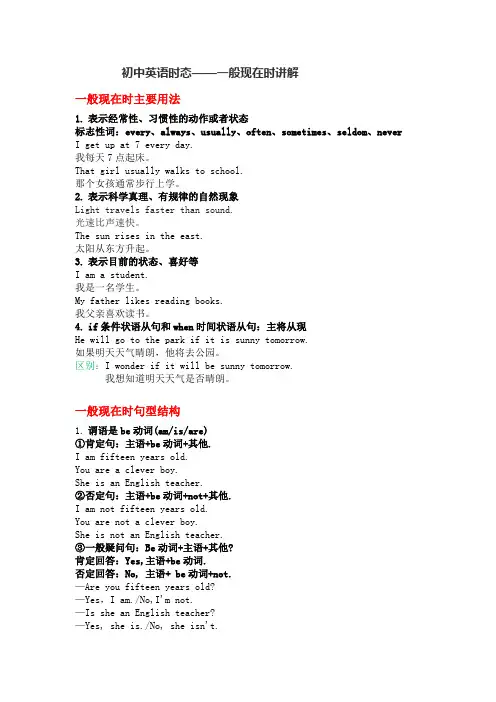
初中英语时态——一般现在时讲解一般现在时主要用法1.表示经常性、习惯性的动作或者状态标志性词:every、always、usually、often、sometimes、seldom、never I get up at 7 every day.我每天7点起床。
That girl usually walks to school.那个女孩通常步行上学。
2.表示科学真理、有规律的自然现象Light travels faster than sound.光速比声速快。
The sun rises in the east.太阳从东方升起。
3.表示目前的状态、喜好等I am a student.我是一名学生。
My father likes reading books.我父亲喜欢读书。
4.if条件状语从句和when时间状语从句:主将从现He will go to the park if it is sunny tomorrow.如果明天天气晴朗,他将去公园。
区别:I wonder if it will be sunny tomorrow.我想知道明天天气是否晴朗。
一般现在时句型结构1.谓语是be动词(am/is/are)①肯定句:主语+be动词+其他.I am fifteen years old.You are a clever boy.She is an English teacher.②否定句:主语+be动词+not+其他.I am not fifteen years old.You are not a clever boy.She is not an English teacher.③一般疑问句:Be动词+主语+其他?肯定回答:Yes,主语+be动词.否定回答:No, 主语+ be动词+not.—Are you fifteen years old?—Yes,I am./No,I'm not.—Is she an English teacher?—Yes, she is./No, she isn't.④特殊疑问句:特殊疑问词+be动词+主语+其他? Where are they?2.谓语动词是实义动词主语是第一人称、第二人称、第三人称复数:①肯定句:主语+动词原形+其他.I have a lot of interesting books.You look nice in the dress.They go shopping every weekend.②否定句:主语+don't+动词原形+其他.I don't have a lot of interesting books.You don't look nice in the dress.They don't go shopping every weekend.③一般疑问句:Do+主语+动词原形?肯定回答:Yes,主语+do.否定回答:No, 主语+ don't.—Do you have a lot of interesting books?—Yes, I do./ No, I don't.④特殊疑问句:特殊疑问词+do+主语+动词原形+其他? When do you go to school?What do they like?主语是第三人称单数:①肯定句:主语+动词第三人称单数+其他.He has a short black hair.Helen likes juice.②否定句:主语+doesn't+动词原形+其他.He doesn't have short black hair.Helen doesn't like juice.③一般疑问句:Does+主语+动词原形+其他?肯定回答:Yes,主语+does.否定回答:No, 主语+doesn't.—Does he have short black hair?—Yes, he does./No, he doesn't.④特殊疑问句:特殊疑问词+does+主语+动词原形+其他? Which subject does your sister like best?Where does he often go after school?3. 谓语是情态动词①肯定句:主语+情态动词+动词原形+其他.I can draw beautiful pictures.He can speak English well.They can borrow some magazines from the library.②否定句:主语+情态动词+not+动词原形+其他.I can't draw beautiful pictures.He can't speak English well.They can't borrow some magazines from the library.③一般疑问句:情态动词Can+主语+动词原形?肯定回答:Yes,主语+情态动词.否定回答:No, 主语+ 情态动词+not.—Can you play volleyball?—Yes,I can./No, I can't.④特殊疑问句:特殊疑问词+情态动词+主语+动词原形+其他?回答:主语+情态动词+动词原形+其他.—What can you do?—I can play the piano.第三人称单数一、人称代词he, she, it是第三人称单数。

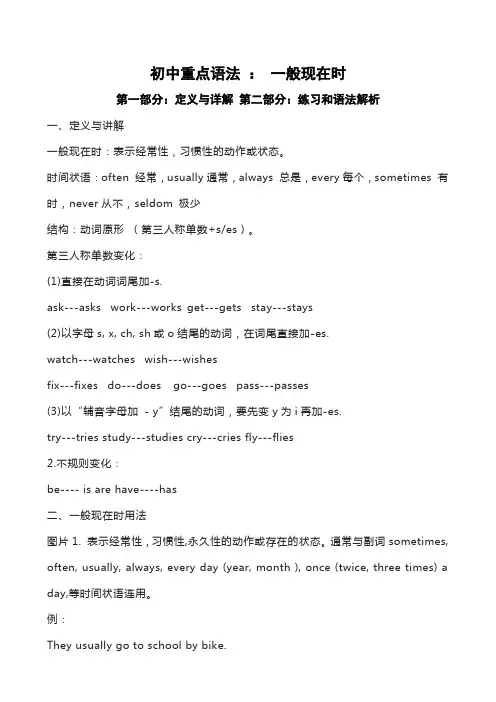
初中重点语法:一般现在时第一部分:定义与详解第二部分:练习和语法解析一、定义与讲解一般现在时:表示经常性,习惯性的动作或状态。
时间状语:often 经常,usually通常,always 总是,every每个,sometimes 有时,never从不,seldom 极少结构:动词原形(第三人称单数+s/es)。
第三人称单数变化:(1)直接在动词词尾加-s.ask---asks work---works get---gets stay---stays(2)以字母s, x, ch, sh或o结尾的动词,在词尾直接加-es.watch---watches wish---wishesfix---fixes do---does go---goes pass---passes(3)以“辅音字母加- y”结尾的动词,要先变y为i再加-es.try---tries study---studies cry---cries fly---flies2.不规则变化:be---- is are have----has二、一般现在时用法图片1. 表示经常性,习惯性,永久性的动作或存在的状态。
通常与副词sometimes, often, usually, always, every day (year, month ), once (twice, three times) a day,等时间状语连用。
例:They usually go to school by bike.I take the medicine three times a day.She helps her mother once a week.Mary’s father is a policeman.There are 50 students in my class.2. 表示客观真理,科学原理,自然现象,等客观事实或格言,谚语等。
例:The sun rises in the east and sets in the west every day.Tomorrow is Tuesday.三、一般现在时的句型转换(1)当句子中有be动词或情态动词时,则把be动词或情态动词(can,could等等)提到主语的前面变成疑问句;在be动词或情态动词后面加not变成否定句.例:①陈述句:She is a student.疑问句→Is she a student?否定句→She is not a student.②陈述句:I can swim.疑问句→Can you swim?否定句→I can not swim.(2) 当句子中即没有be动词,也没有情态动词时,则在主语前加助动词do (you,以及复数), does(单数she,he,it)变成问句;在主语后谓语动词前加助动词don’t(I,you,以及复数), doesn’t(单数she,he,it)变成否定句,助动词后的动词要变成动词原形。
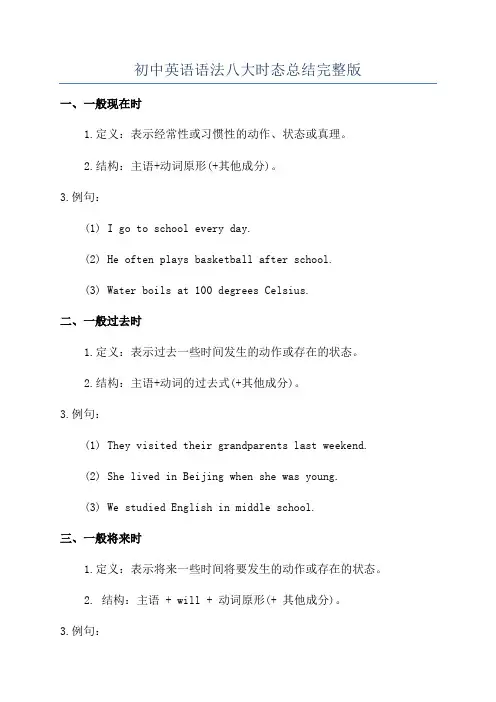
初中英语语法八大时态总结完整版一、一般现在时1.定义:表示经常性或习惯性的动作、状态或真理。
2.结构:主语+动词原形(+其他成分)。
3.例句:(1) I go to school every day.(2) He often plays basketball after school.(3) Water boils at 100 degrees Celsius.二、一般过去时1.定义:表示过去一些时间发生的动作或存在的状态。
2.结构:主语+动词的过去式(+其他成分)。
3.例句:(1) They visited their grandparents last weekend.(2) She lived in Beijing when she was young.(3) We studied English in middle school.三、一般将来时1.定义:表示将来一些时间将要发生的动作或存在的状态。
2. 结构:主语 + will + 动词原形(+ 其他成分)。
3.例句:(1) I will go to the park tomorrow.(3) We will have a party next week.四、现在进行时1.定义:表示现在正在进行的动作。
2. 结构:主语 + am/is/are + 动词-ing(+ 其他成分)。
3.例句:(1) She is reading a book right now.(2) They are playing soccer in the park.(3) We are having dinner at the moment.五、过去进行时1.定义:表示过去一些时间正在进行的动作。
2. 结构:主语 + was/were + 动词-ing(+ 其他成分)。
3.例句:(1) He was watching TV at 8 o'clock last night.(2) They were traveling in Europe during summer vacation.(3) We were studying when the phone rang.六、将来进行时1.定义:表示将来一些时间正在进行的动作。
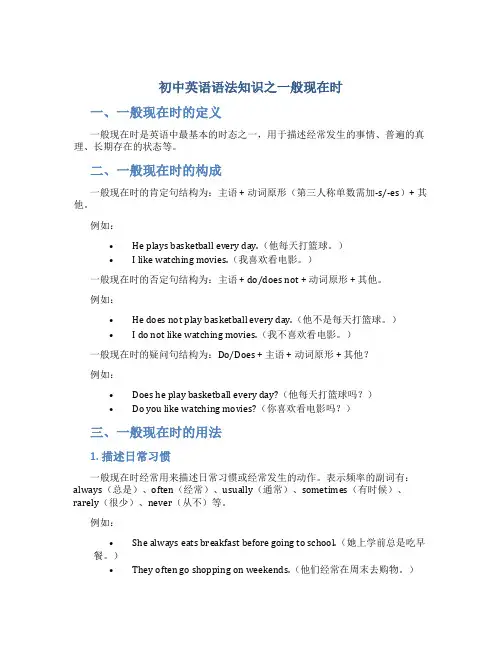
初中英语语法知识之一般现在时一、一般现在时的定义一般现在时是英语中最基本的时态之一,用于描述经常发生的事情、普遍的真理、长期存在的状态等。
二、一般现在时的构成一般现在时的肯定句结构为:主语 + 动词原形(第三人称单数需加-s/-es)+ 其他。
例如:•He plays basketball every day.(他每天打篮球。
)•I like watching movies.(我喜欢看电影。
)一般现在时的否定句结构为:主语 + do/does not + 动词原形 + 其他。
例如:•He does not play basketball every day.(他不是每天打篮球。
)•I do not like watching movies.(我不喜欢看电影。
)一般现在时的疑问句结构为:Do/Does + 主语 + 动词原形 + 其他?例如:•Does he play basketball every day?(他每天打篮球吗?)•Do you like watching movies?(你喜欢看电影吗?)三、一般现在时的用法1. 描述日常习惯一般现在时经常用来描述日常习惯或经常发生的动作。
表示频率的副词有:always(总是)、often(经常)、usually(通常)、sometimes(有时候)、rarely(很少)、never(从不)等。
例如:•She always eats breakfast before going to school.(她上学前总是吃早餐。
)•They often go shopping on weekends.(他们经常在周末去购物。
)2. 表达客观事实或普遍真理一般现在时也被用来表达客观事实或普遍真理。
例如:•The Earth revolves around the sun.(地球绕太阳运行。
)•Water boils at 100 degrees Celsius.(水在100摄氏度沸腾。
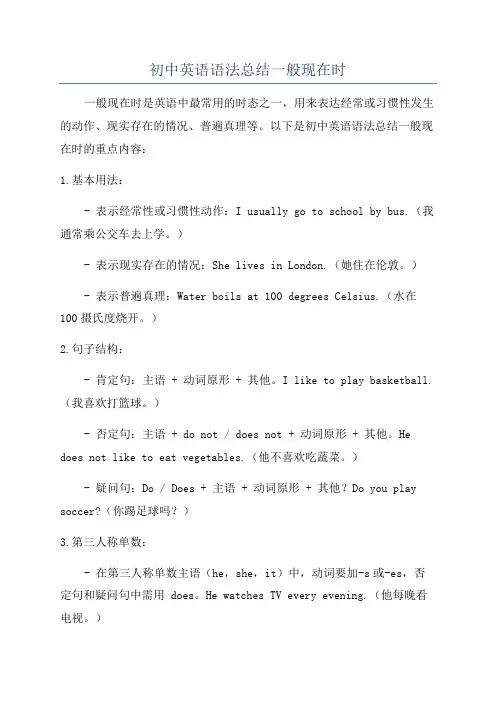
初中英语语法总结一般现在时一般现在时是英语中最常用的时态之一,用来表达经常或习惯性发生的动作、现实存在的情况、普遍真理等。
以下是初中英语语法总结一般现在时的重点内容:1.基本用法:- 表示经常性或习惯性动作:I usually go to school by bus.(我通常乘公交车去上学。
)- 表示现实存在的情况:She lives in London.(她住在伦敦。
)- 表示普遍真理:Water boils at 100 degrees Celsius.(水在100摄氏度烧开。
)2.句子结构:- 肯定句:主语 + 动词原形 + 其他。
I like to play basketball.(我喜欢打篮球。
)- 否定句:主语 + do not / does not + 动词原形 + 其他。
He does not like to eat vegetables.(他不喜欢吃蔬菜。
)- 疑问句:Do / Does + 主语 + 动词原形 + 其他?Do you play soccer?(你踢足球吗?)3.第三人称单数:- 在第三人称单数主语(he,she,it)中,动词要加-s或-es,否定句和疑问句中需用 does。
He watches TV every evening.(他每晚看电视。
)- 一些以s, sh, ch, x, o结尾的单词,需要在动词后加-es,如:misses,washes,watches。
4.频率副词:- 频率副词通常放在动词之前,用于修饰动词。
例如:She always helps others.(她总是帮助别人。
)5.现在进行时与一般现在时的区别:- 现在进行时表示现在正在发生的动作,一般与现在时间状语连用,或表示现阶段的临时情况。
例如:I am studying for the exam.(我正在准备考试。
- 一般现在时表示经常性、习惯性的动作或客观存在的状态。
例如:I usually play soccer on weekends.(我通常在周末踢足球。
中考语法复习— 一般现在时(附真题及解析)一、一般现在时的构成1.含b e动词的一般现在时肯定:主语+be ( am/is/are)+其它否定:主语+be ( am/is/are) not+其它一般疑问句:Be ( Am/Is/Are)+主语+其它?特殊疑问句:特殊疑问词+be( am/is/are)+主语+其它?She is a teacher. She isn’t a teacher.— Is she a teacher?— Yes, she is./ No, she isn’t.2.含实义动词的一般现在时肯定:主语+实意动词原形/单三+其它否定:主语+don't/doesn't+动词原形+其它一般疑问句:Do/Does+主语+动词原形+其它?特殊疑问句:特殊疑问词+d o/d o e s+主语+动词原形+其它?Helen works hard.Helen doesn't work hard.— Does Helen work hard?— Yes, she does./No, she doesn't.How does Helen work?注意:在一般现在时的结构中,动词的形式由主语的单复数决定。
主语是第一人称或复数时,谓语动词用其原形;主语是第三人称单数时,谓语动词用单三形式。
现将动词单三的规则变化及其读音总结如下:二一般现在时的用法1.表示经常性或习惯性的动作,常与表示频度的时间状语连用。
如:My grandparents always take a walk in the park after supper.2.表示客观真理、客观存在以及科学事实。
The speed of light is faster than the speed of sound.光速比声速快。
3.用在表示格言或警句中。
Where there is a will, there is a way.有志者事竟成。
初中英语语法知识之一般现在时有很多同学分不清时态,时态是一篇文章的主线,如果时态都分不清那我们就分不清事情发生的先后,会对我们做题设障碍,所以今天小编为大家整理了一些时态上的知识,希望能帮到大家。
一般现在时表示现在经常反复发生的动作、存在的状态或习惯性的动作的时态。
一、一般现在时用法如下:1.表示现在的状态: e.g. He’s twelve. She’s at work.2.表经常或习惯性的动作,常与表示频度的时间状语连用。
: eg. I get up at 6:30 every day.He reads English every morning.3.表主语具备的性格、能力和特征。
e.g. I don't like this book.4.表示客观事实和普遍真理。
The earth moves around the sun.5. 在时间状语从句和条件状语从句中,常用一般现在时代替将来时。
eg. I'll write to you as soon as I arrive there.二、一般现在时构成:一般现在时用行为动词的原形,但第三人称单数作主语时,动词要用第三人称单数形式。
第三人称单数形式的变化规则是:1.一般的动词词尾+S。
2.以sh/ch/s/x 结尾的词+es.3.以辅音字母+Y 结尾的把 Y 变成 i,+es。
4.辅音字母+o 结尾的+es.基本结构:1.be 动词肯定句:主语+be(am,is,are)+其它。
如: I am a boy.我是一个男孩。
否定句:主语+ be + not +其它。
如:He is not a worker.他不是工人。
一般疑问句:Be +主语+其它。
如:-Are you a student? -Yes. I am. / No, I'm not.特殊疑问句:疑问词+一般疑问句。
如:Where is my bike?2.行为动词1) 当主语为第一,二人称及复数时,助动词为 do肯定句:主语+动词原形(+其它)。
一般现在时与一般过去时的区别初中语法重点解析一般现在时和一般过去时是英语语法中两种最基本的时态。
它们在使用上有所不同,主要表达现在和过去的动作或状态。
本文将对这两种时态的区别进行初中语法重点解析。
一、一般现在时一般现在时用于描述经常性、习惯性或普遍性的动作或状态。
1. 基本句式结构:主语 + 动词的原形(一般动词加-s或-es)2. 表达经常性习惯的词语:常常(often)、通常(usually)、有时候(sometimes)、总是(always)等。
3. 示例:- I often go to the park on weekends.(我经常在周末去公园。
)- She usually reads books before bedtime.(她通常在睡前看书。
)二、一般过去时一般过去时用于描述过去发生的动作或状态。
1. 基本句式结构:主语 + 动词的过去式形式2. 表达过去的时间段词语:昨天(yesterday)、上个月(last month)、去年(last year)等。
3. 示例:- We visited our grandparents last weekend.(上个周末我们去看望了祖父母。
)- It rained heavily yesterday.(昨天下了一场大雨。
)三、一般现在时与一般过去时的区别1. 时间参照点:一般现在时是以现在为参照点,即描述现在或经常性的动作或状态;而一般过去时以过去某个具体时间为参照点,描述过去已经发生的动作或状态。
2. 动词形式变化:一般现在时中,动词一般保持原形,但第三人称单数要加上-s或-es。
而一般过去时中,动词需变为过去式形式。
3. 时间状语的使用:一般现在时通常结合时间状语词或者副词来表示经常性的动作或状态;而一般过去时则结合过去的时间段词语。
4. 示例比较:- 现在:- I often play basketball in the park.(我经常在公园打篮球。
初中英语语法八大时态一.一般现在时1.结构肯定句式: 主语+动词原形/动词的第三人称单数+其他否定句式: 主语+(助动词)don't/doesn't +动词原形+其他一般疑问句式: Do/Does+主语+动词原形+其他简略回答: (肯)Yes,主语+do/does (否)No,主语+do/does not缩写形式: don't = do not doesn't = does not例句:He often goes swimming in summer.I usually leave home for school at 7 every morning.2.用法1)表示经常的、习惯性的动作或存在的状态,常与表示频度的副词连用。
常用的频度副词有:always、often、usually、seldom、never、sometimes, every week (day, year, month…), once a week, on Sundays.频度副词在句中通常放在行为动词之前,系动词、助动词之后。
例如: He often goes swimming in summer.I usually leave home for school at 7 every morning.2)表示主语具备的性格、特征和能力等。
例如:All my family love football .My sister is always ready to help others .Ann writes good English but does not speak well.3)表示客观真理、客观存在、自然现象。
例如:The earth moves around the sun.Shanghai lies in the east of China.4)表示按计划或安排好的,或将要发生的动作,可用一般现在时表将来。
初中语法一般现在时
导读:我根据大家的需要整理了一份关于《初中语法一般现在时》的内容,具体内容:我们的英语语法有哪些,大家知道吗?接下来,我给大家准备了,欢迎大家参考与借鉴。
一、表示一般性或经常发生的动作或状态1) In general [A] , new...
我们的英语语法有哪些,大家知道吗?接下来,我给大家准备了,欢迎大家参考与借鉴。
一、表示一般性或经常发生的动作或状态
1) In general [A] , newspapers emphasize current news, whereas1
[B] magazines dealt [C] more with [D] background materials.
2) The adult mosquito usually lives for about [A] thirty days,although [B] the life span2 varied3 [C] widely with temperature,humidity4, and other [D] factors of the environment.
3) Industrial buyers [A] are responsible [B] for supplying [C] the goods and services that an organization required [D] for its operations.
二、表示习惯性动作和状态或普遍的现象或常识
4) It is an accepted [A] custom in west countries that [B] men removed [C] their hats when a woman enters [D] the room.
5) Certain layers of the atmosphere have special names .
[A]which indicated their character properties
[B]whose characteristic properties were indicating
[C]what characterize5 their indicated properties
[D]that indicate their characteristic properties
三、表示客观事实、客观规律和客观真理。
在宾语从句中,即使主句的谓语动词用了过去时,只要从句表示的是客观真理,从句的谓语动词也要用一般现在时。
6) The teacher told them since [A] light travels faster than [B] sound, lightning appeared [C] to go before [D] thunder.
7) As [A] a child, I was told that [B] the planet earth, which has [C] its own satellite, the moon, moved [D] round the sun.四、祈使句必须用动词原形,其否定结构用"dont+动词原形",如:
Go and fetch some water. / Dont do that.
五、在反义疑问句中,如果主句用肯定句,那么,反问句用否定形式;如果主句用否定形式,那么,反问句就用肯定形式。
而且前后在时态上要一致。
但祈使疑问句用wont you?进行反问。
如:See a film tonight, wont you?
注:① 祈使句后边可用附加疑问句,以加强语气。
如果祈使句用肯定形式,附加疑问句用否定形式;如果祈使句用否定形式,附加句用肯定形式;如: Come here next Sunday, wont you? / Dont tell it to anyone, will you? ② 但如果祈使句的前一句有了表示强烈[ZZ(]肯定[ZZ)]的语言环境,即使祈使句用了肯定形式,其附加成分也可以用"will you"(表示肯定,如果是在口语中用降调)。
如:Give me the book, will you?
扩展:初中语法解析-一般将来时
一、一般将来时表示将要发生的动作或状况。
1) But the weather experts [A] are now paying more attention to West Antarctic1, which may be affected2 [B] by only a few degrees of warming: in other words, by a warming on the scale that would
[C] possibly take place in the next fifty years from the burning
[D] of fuels.(92年阅读理解题)
2) If traffic problems are not solved soon [A], driving [B] in
[C] cities becomes [D] impossible.
二、在表示时间和条件的状语从句中,一般现在时代替一般将来时。
这些时间副词有when, as soon as等,表示条件的连词有if, as long as 等。
3 ) A desert area that has been [A] without water [B] for six years will still [C] bloom3 when rain will come [D] .
4) Come and see me whenever ___.(84年考题)
[A] you are convenient [B] you will be convenient
[C] it is convenient to you[D] it will be convenient to you
5) The task is extremely difficult. If no one ___able to do it, we will have to find somebody else.
[A] were
[B] was
[C] is
[D] would
注意:如果这些副词或连词引导的是名词从句作宾语而不是状语从句时,这些名词从句的谓语动词则用该用的时态:I dont know when he will come.而且表示将来的助动词will还可以用以条件从句中,译为"愿意、肯"等。
三、一些表示方向及变化的瞬间动词可用进行时或现在时表示将要发生的动作。
We leave (are leaving) for California the day after tomorrow.我们(计划)后天动身去加利福尼亚州。
May I have your attention please. The plane for Wuhan is about to take off.请注意,飞往武汉的飞机就要起飞了。
四、另外,"be +to +动词原形"也可表示打算做的事,还可表示责任、意向和可能性。
You are to follow the doctors advice.你应遵从医嘱。
No shelter was to be seen.找不到避难处。